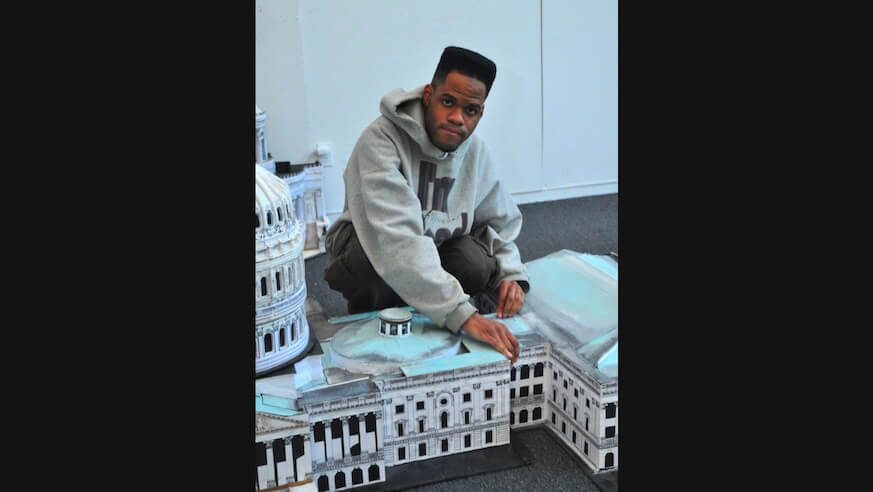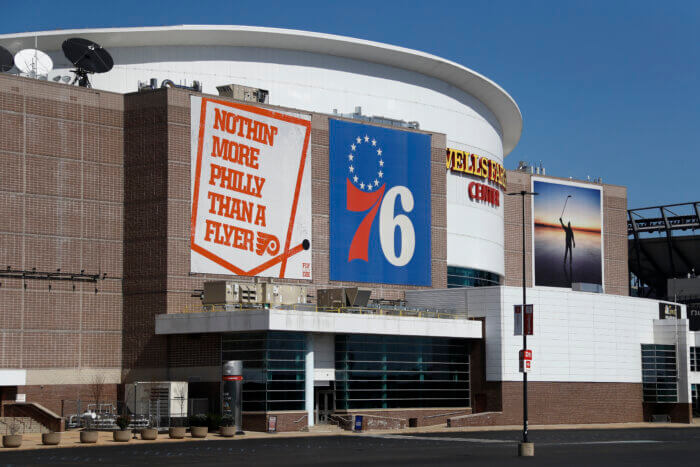Inside a Germantown home, a self-taught artist who most people have never heard of spends his days creating real-life versions of his visions — in comic books, oil paintings, and most recently, large cardboard re-creations of buildings around Philadelphia and the nation.
Kambel Smith, 32, who was diagnosed as a child with various intellectual disabilities before being labeled as autistic, doesn’t talk much with outsiders about his art.
“I’m just thinking about trying to make it look like real life,” Kambel says when asked about the meaning of the works he is creating now after more than 15 years of developing his art.
To his father Lonnie Smith, art is Kambel’s vocation: “He constantly constructs, paints. From the time he gets up in the morning ’til maybe 2-3 in the morning, and he enjoys it, no pressure, he puts his headphones on and just goes at it,” Lonnie said. “I have to say, ‘Stop, you have to eat.’ That’s just his thing, to create.”

Philly self-taught artist Kambel Smith, right, who has been diagnosed with autism but identifies himself as Autisarian, with father Lonnie Smith, center, and brother Kantai Smith, a fellow Autisarian, in their Germantown home, where Kambel is creating his newest works. (Sam Newhouse)
But soon, a lot more people will be learning about Kambel’s works.
Smith’s hand-made constructions of Philadelphia landmarks — from the Art Museum to Independence Hall and the PSFS building — were featured prominently at last month’s international Outsider Art Fair (OAF) in Manhattan, where they got heavy attention from critics in attendance.
Just weeks later, New York’s American Folk Art Museum acquired Kambel’s re-creation of Philly’s famous Divine Lorraine hotel. The Oaks-based West Collection scooped up his models of PSFS Building and Philadelphia City Hall.
This week, Kambel got confirmation of his first-ever museum show at the Atlanta Contemporary, opening in April, and his work is set to be included in a September art show in Brooklyn focused on black science fiction.
“It was just like a rush,” said Lonnie. “He’s been painting for 15 years, and we’ve been trying to get his work out there for almost all of it.”
Kambel’s career took a huge step forward after a neighbor and friend posted about his work on Facebook — then linked him to curator Chris Byrne, owner of the Elaine de Kooning House in East Hampton, New York, who just months later had Kambel’s work on view in the OAF.
“It’s magical and transformative, what he does with the city just by shifting its scale, he kind of humanizes it … it’s still monumental, but wonderful in the way that artists make their own world,” said art critic and curator Carlo McCormick, who met Kambel at the OAF.
While the term “outsider” covers a wide variety of people, artists who are self-taught and didn’t receive traditional training are particularly popular in the art world at present, he added. They’re “creating art sometimes in the purest of ways because it’s what helps them express themselves and function in a world that in many ways has silenced their voice,” McCormick said.

Kambel Smith at the booth including his works in the Outsider Art Fair, with curator Chris Byrne (right), owner of the Elaine de Kooning House, and art critic Carlo McCormick, left.
(Courtesy of the Elaine de Kooning House)
That could certainly apply to Kambel, who for years was labeled by educators and psychiatrist as having various intellectual disabilities before being diagnosed with autism, according to his father. One psychiatrist even urged Lonnie to give his son electroshock therapy, but Lonnie refused.
It was around this time, when Kambel was not yet 10, that Lonnie discovered his son’s hidden talents, when he discovered Kambel’s secret stash of drawings of his own imaginary heroes, hidden inside a wall vent.
“I pulled it off and a bunch of crumpled-up pieces of paper fell out. Had to be at least 50 to 60, maybe more. … I examined them and they had pictures of a character he had drawn. He called the character ‘Survivor,'” Lonnie explained. “He was trying to reach out, but no one would listen. When I found out what he could do and started listening to him, hearing what he was saying, he was asking for help, through the pictures.”
From then on, father and son became artistic collaborators — Lonnie started creating a story about the characters Kambel was drawing that he would tell his son, who kept drawing out new scenarios and new characters as the story evolved. The process that went on for years — and continues to this day, Lonnie said.
Gifts from family members of paint and easels accelerated Kambel’s artistic growth. When they ran out of canvas and supplies, Kambel started collecting old Amazon cardboard boxes and went straight to creating models. He creates the meticulously detailed works freehand, worked off photos of the buildings but without any schematics or official measurements. At this point Kambel is close to having “a whole city” of works, Lonnie said.

Several of Kambel’s Philly-inspired works. (Courtesy of the Elaine de Kooning House/Katherine McMahon)
Given Kambel’s talents, Lonnie rejects the label of “autistic” for either of his sons — Kambel or Kantai, 24, another prodigy who is a computer programming whiz.
Lonnie prefers the term he created, “Autisarian” — not a scientific or medical word, but one that reflects his sons’ abilities, rather than labeling them as having a disability.
“You’re not autistic, you’re Autisarian. Find the gift,” is what Lonnie said he tells other people with the same diagnosis. “My definition for Autisarian would be a person who has gifts left by autism, a person who has found and accepted those gifts. I believe that all autistic children have that in them. I ain’t saying that for sure, and maybe not — but I would challenge somebody to say, ‘Hey, you prove to me that they don’t.'”
Whatever term you use, Kambel has many of the same traits as any other artist. He said his favorite artists are Bob Ross and Norman Rockwell, and one reaction to his work he was most pleased with at the OAF was that of a young boy photographed standing before his Betsy Ross House model, transfixed by the minute details of the original, 13-starred flag out front.
“It’s bigger than him,” Kambel said after seeing the photo. “He’s been inspired.”
To learn more about Kambel and Lonnie’s works, visit http://www.Autisarian.com.
To support Lonnie’s plans to open a public art studio for Kambel in Philadelphia, visit gofundme.com/kambel-art-show.



























